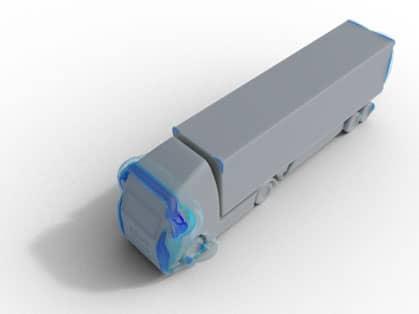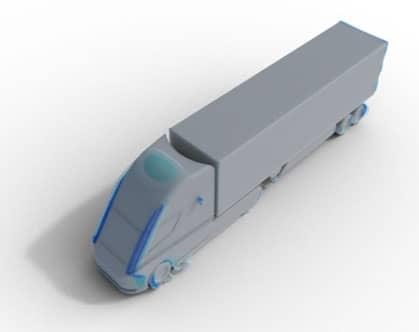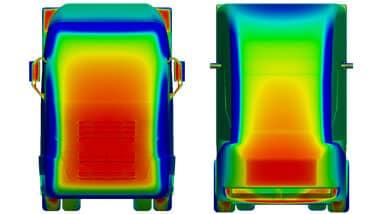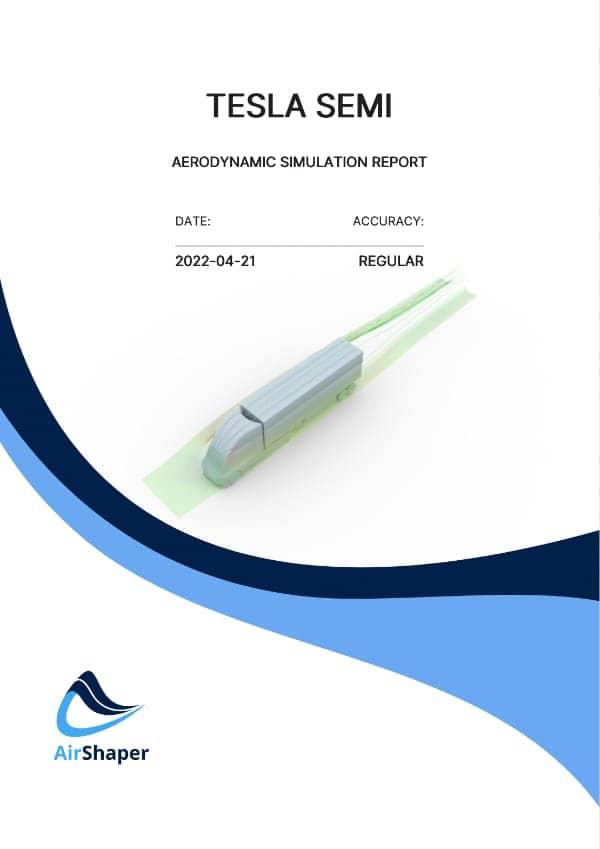Tesla Semi, put to the test Truck
Transportation emissions
When large amounts of cargo need to be delivered at specific locations, heavy-duty trucks offer a very practical solution: door-to-door transport connecting most locations that are accessible via the often-dense road networks. But lately, heavy-duty transport in general has been facing increasing pressure: lorries, buses and coaches produce around a quarter of CO2 emissions from road transport in the EU and around 5% of the EU’s total greenhouse gas emissions – a greater share than international aviation or shipping (EU).

A changing world
With stricter CO2 regulations being drafted and released in various parts of the world, action is being taken. On the power generation side, engines are becoming more and more efficient to reduce fuel consumption. On the power consumption side, efforts are made to reduce aerodynamic drag, as it constitutes more than 50% to keep a truck moving at 60 mph. But this is not easy: typically, trucks and trailers are bulky objects that have been stretched to make use of every cubic inch that is allowed by road regulations (such as maximum length & height).
Long way to go
It’s not hard to see that the aerodynamic efficiency of conventional box-shaped trucks is quite low. This efficiency is typically expressed via the drag coefficient Cd (a measure for how streamlined a body is irrespective of its size – lower is better), typically between 0.5 and 0.8 for heavy duty trucks (including the trailer).
Despite numerous research initiatives featuring curved trailers, rear-end fairings, enclosed wheels etc., the majority of heavy-duty trucks on the road still feature the conventional boxy outfit. Recently however, Tesla launched their Semi truck: without any constraints imposed by existing platforms, component supplier contracts or previous truck designs, they took a radical approach. They claim a drag coefficient of 0.35, doubling its aerodynamic efficiency compared to normal trucks and putting it on par with drag coefficients of typical road cars.
So how real are these claims?
To find out, we used our online aerodynamics platform to automatically go from a 3D model to a finished simulation report. As for the 3D model itself, we asked our partnering engineering firm Voxdale to build a 3D model of the new Tesla Semi: based solely on images off the internet, they took a conservative approach whenever in doubt, making it slightly boxier. As a reference, Voxdale also drew a conventional truck, in its most competitive setup possible (e.g. very small gap between truck and trailer), to make the comparison as tough as possible.
The results? A drag value of 0.34 for the Tesla truck and 0.43 for the reference truck. Our estimation is that with more detailed models, these values may still vary, although the addition of more details (which typically increases drag) is probably compensated by a smoother shape (instead of our internet-image-based 3D model for Tesla). For the reference truck, the shape itself is already quite close and the addition of details might further increase drag values. Nevertheless, the Tesla Semi already reduces drag by 20%.
But numbers don’t tell the full story: how did they actually achieve this? Once a simulation is done, it needs to be translated into facts & visuals that can be interpreted towards design improvements. A typical example is to show 3D clouds of the “under pressure” (suction effect), as shown in the images below. The bluer the cloud, the lower the “under pressure” and possibly the greater the contribution to drag. It’s clear to see why they have replaced the mirrors with short camera sticks!


Another way of analysing the aerodynamics is to look at pressure on the surface of the object. A flat plate positioned perpendicular to the wind will typically cause a lot of pressure build-up. The same goes for a boxy truck, with a large frontal face trying to push away all the air at once. The images below show this pressure pattern for both trucks. It is clear that the swept back profile and the tapered shape (in top view) of the Tesla Semi cabin do a great job at reducing the pressure build-up. Perfectly aligning the cabin with the trailer (note the top corners!) also helps a great deal.

So, do we believe the figures stated by Tesla?
Until we receive a fully detailed 3D model from Mr. Elon Musk it remains impossible to provide a final conclusion, but all indicates that they have indeed pulled it off. You can download the full reports of both trucks below if you are interested in more information. We hope that by providing automated simulations & visualizations through our AirShaper platform, we can enable other designers & engineers to optimize the aerodynamics of their truck, bus, drone etc. to reduce emissions and increase range & top speed!



